2023 marks the 40th anniversary of what many consider to be the first “official” Pride march in Dublin in 1983. It didn’t happen in a vacuum. It was preceded by more than a decade of LGBTQ+ organising, informed by and overlapping with feminist activism.
In 1970, Pride marches in multiple US cities and London marked the first anniversary of the 1969 Stonewall Riots in New York City, the catalyst for the LGBTQ+ rights movement globally. In Ireland, both the Sexual Liberation Movement – born at a meeting in Trinity College – and the Belfast Gay Liberation Society were founded in 1973.
On June 27th, 1974, the first Dublin gay rights demonstration took place at the British Embassy and the Department of Justice, with a dozen people including pioneering activists Hugo André Mac Manus, Margaret McWilliam and Jeffrey Dudgeon, protesting laws against homosexuality in the south and north of Ireland. Around the same time, the Irish Gay Rights Movement (IGRM) was formed.
David Norris: When we got up to the Department of Justice, the secretaries were all up on the first floor with their eyes out on stalks looking at us. We had placards and mine said: “Homosexuals Are Revolting.”
Edmund Lynch: There were people bringing in furniture into the Department and the guys saw us picketing outside and they wouldn’t pass us.
Norris: A lorry drove up and the minister’s carpet was heaved out on to the side of the road. And the helper got out and took one look at us and said, “F**king queers.”The driver got out and said, “I don’t give a b****cks. A pickets a f**kin’ picket mate.” And he took up my picket and marched around with us for half an hour.
Lynch: It wasn’t like they were supporting gay rights. They just had the attitude that they never passed a picket.
Norris: It was to show we were ordinary people and weren’t a threat. When I did an interview [on RTÉ’s Last House in 1975], at first, they said, “We’ll put you in profile, in shadow,” and I said, “If so, I’m not doing it. The whole point is to show that we’re not monsters.”
The LGBTQ+ rights movement was growing. In 1977, Norris and Lynch left the IGRM to form the Campaign for Homosexual Law Reform (CHLR). Norris initiated his High Court challenge against the laws that criminalised sexual acts between men in Ireland. In the North, Jeffrey Dudgeon began the legal process that would lead to decriminalisation there in 1982.
Liberation for Irish Lesbians (LIL) was founded in 1978. Lesbian activists had strong connections with the Irish Women’s Liberation Movement, founded in 1970, and Irish Women United, formed in 1975. Norris and Lynch were among the founders of the National Gay Federation (NGF) in 1979, establishing the Hirschfeld Centre in Temple Bar, with a community centre and disco. There were conferences, symposia, helplines (such as Tel-A-Friend) and pickets throughout the late 70s and 80s.

Dr Patrick McDonagh (author): There was a Gay Association International conference in 1981 and Ireland had three gay organisations represented. Italy had one.
Bill Foley: I was a founding member of the Dublin Lesbian and Gay Men’s Collective [initially the Dublin Gay Collective] formed in around 1981. Rather than just looking at, for instance, law reform and social spaces, we felt there was a need for social reform – changing people’s attitudes. We were deliberately trying to do that by forming links on the broad left.
Joni Crone (LIL): The members of these groups often overlapped. We attended meetings, marches, pickets, protests, fundraising events, letter-writing campaigns before the internet, mobile phones and before newspapers or magazines would accept notices or advertisements from lesbian, gay or left groups.
Foley: To us, it was very clear that having bodily autonomy for women was very close to what we were looking for in terms of LGBT rights, to love or have sex with whoever you like. But it was a controversial topic in the scene itself.
Early Pride events
There were Pride celebrations before the 1983 parade. From 1979, they become more ambitious in scale. In 1980, Pride Week, run by the NGF and LIL, coincided with the opening of Norris’s High Court case and featured high-profile guests: George Weinberg, the psychologist who coined the term “homophobia’”; activist and film historian Vito Russo; Fr Micheál Mac Gréil, a Jesuit who supported Norris’s case; and Dr Noël Browne, the first Irish parliamentarian to call for decriminalisation.
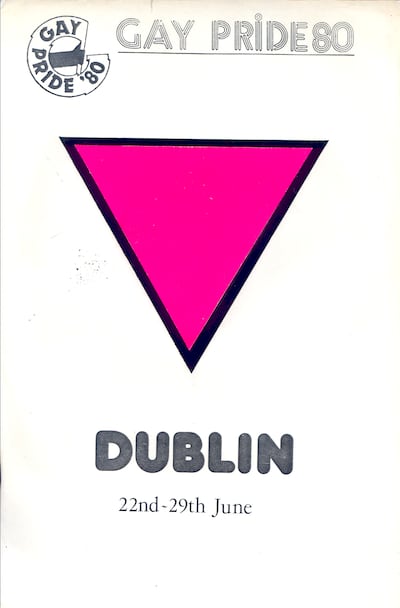
Tonie Walsh (NGF): [Browne] came down to the Hirschfeld to unveil the [centre’s] plaque. I was 19 and I was looking after the brass plaque – it cost £40. I was so scared of losing it so I put it somewhere safe and then couldn’t find it. Edmund Lynch got the RTÉ props department to make a plaque from white perspex, wrote “Hirschfeld Centre” on it and taped it to a wooden plinth. I found the brass plaque a little while later. It’s in the Little Museum of Dublin now.
After the unveiling, we trotted into town and gave out four-page leaflets. There was a pink triangle on the front. The day before, we went down to the flower market in Smithfield and bought boxes of pink carnations and gave them out on the street. People were simply unprepared for it. They didn’t know how to react.
Maura Molloy (DGC): We used to go to a Pride picnic in Merrion Square [with] a very small banner and a very small number, maybe 40 of us. One year, the great liberal worthies of Ireland were unveiling, I think, a bust of Nelson Mandela, while park officials were threatening us with eviction which we thought was just hilariously ironic. So, a couple of us went over and said to the people from the ICCL [Irish Council for Civil Liberties] and Labour: “Do you realise that there’s a civil-rights group getting threatened?” So, they talked to the park officials and they backed off.
Walsh: There were pub zaps in ‘79, ‘80, ‘81, ‘82, right throughout the 80s. The pub zaps had a group of men and women descending on a bar. We’d go in, sit down, put our gay badges on, people would order and look faggoty and dykey. In five out of eight bars in Dublin 2 in ‘81, we were refused drinks.
Pauline O’Donnell (Lesbian Line): Sometime in 1980, JJ Smyth’s in Aungier Street became host to the longest-running lesbian disco in Dublin. We hired one of the old turntable decks each week and blasted out all the disco hits of the day on vinyl: Tina Turner, The Pointer Sisters and Donna Summer. JJs was a safe haven for women of all ages and walks of life who could be themselves for a few hours once a week.
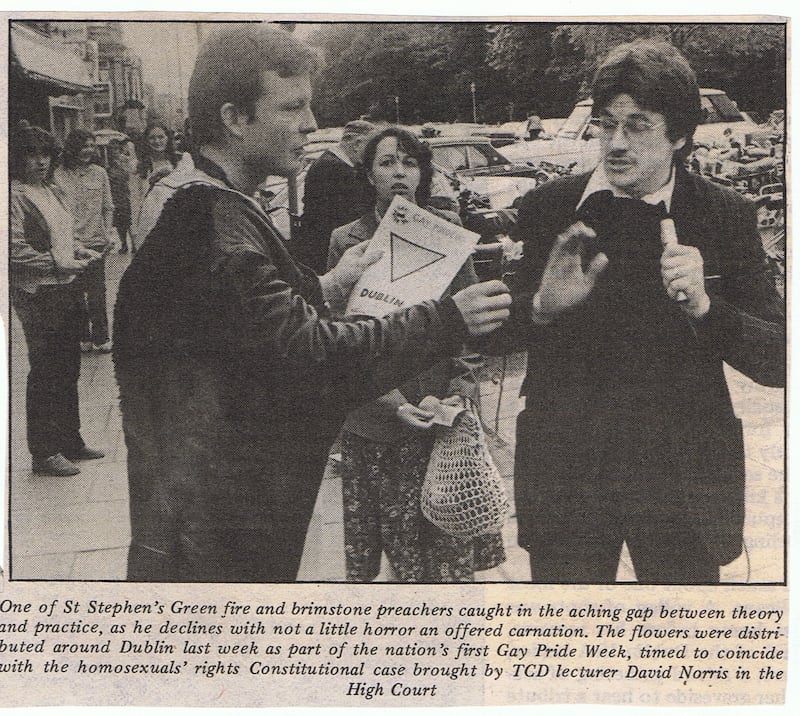
Foley: There were Pride marches before [83]. They were very small.
Molloy: There was always the thing about how many people were you out to? Would people from work or family see you there?
Foley: We had missiles and anti-gay slogans thrown at us. You did feel fairly vulnerable. Just a small group of people wandering around the streets of Dublin, with various banners ... It was just something that we gritted our teeth and did.
In January 1982, Charles Self, an RTÉ set designer, was murdered in his home in Monkstown in Dublin. The murder remains unsolved. A controversial garda investigation began.
Foley: 1,500 men were interviewed. It seemed more like gay profiling rather than an investigation of a murder.
Lynch: They caught up with me and said, “Where were you on the night?” I said, “You’d better check with the RUC, I was up there working for RTÉ.” The cops were getting tired seeing me. I got a young solicitor and we used to appear when anyone had trouble.
[ Dublin LGBTQ+ Pride Festival to mark 50 years of sexual liberationOpens in new window ]
Report from The Irish Times, March 20th, 1982: Homosexuals complain that gardaí have been demanding they agree to be fingerprinted, photographed and give statements. They claim that detectives have repeatedly called to their homes and places of work causing them considerable embarrassment. Some also claim that family anguish has been caused when they were forced to reveal details of their sex lives to their parents because of the gardaí.
Cathal Kerrigan (DGC): They went around to their families and workplaces. It helped to radicalise a lot of those middle-class gay men. We organised the picket of Pearse Street Garda station in ‘82.
The Fairview March 1983
In September 1982, Declan Flynn, an Aer Rianta worker, was beaten to death in Fairview Park in Dublin. The following March, Justice Gannon gave suspended sentences to the killers. A protest march to Fairview Park was organised for March 19th, 1983.
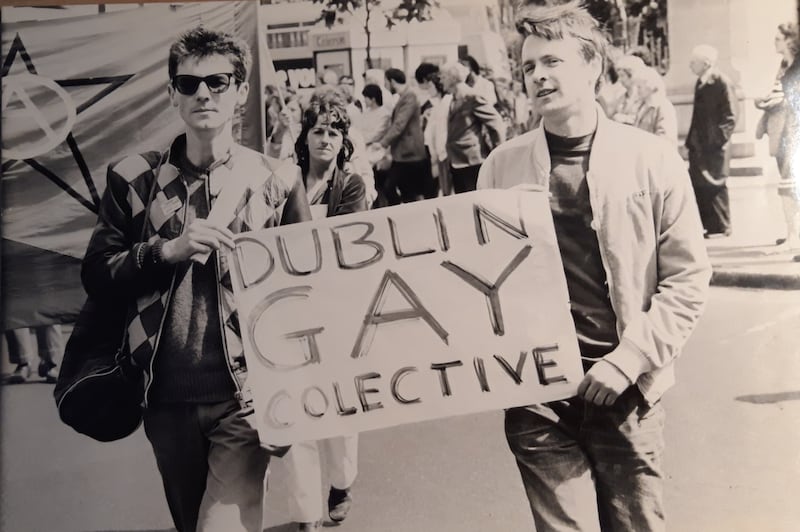
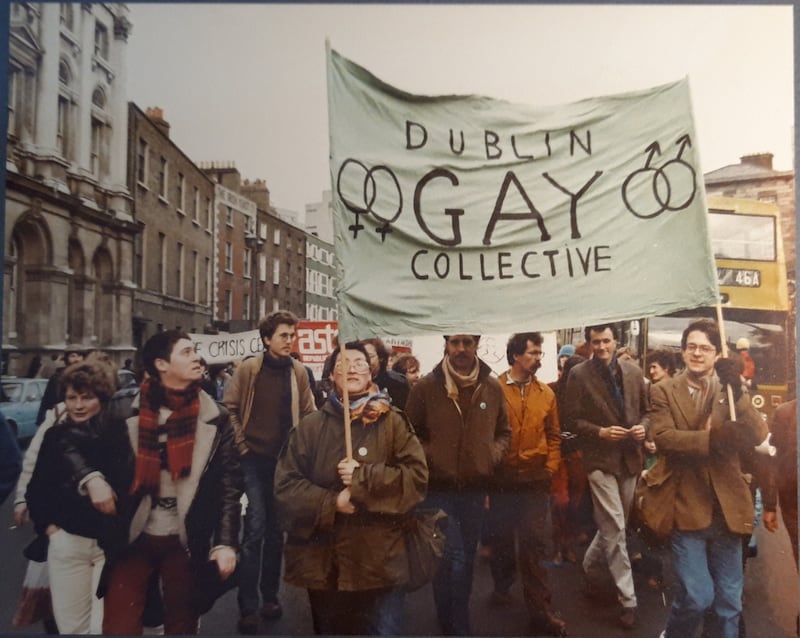
Crone: Declan Flynn’s murder sent shock waves through the community and also strengthened the bonds that existed between activists campaigning for gay rights, women’s rights and worker’s rights.
Molloy: In late ‘82, there was a women’s Reclaim The Night march after a series of awful sexual assault cases. Everybody in [the DGC] were active members of the local anti-[8th] amendment campaigns. For Fairview and for Pride, we went to all these other groups and said, “Support us, we have a common cause ... We want you to experience what it feels like to be gay for the day.”
We walked fast. A couple of women caught up with us at Fairview park and said, ‘You went like the clappers’
— Maura Molloy
Kerrigan: Standing around a table writing the placards, I said, “What if nobody turns up?” And [Molloy] said, “If none of them turn up, we will go down to every one of those organisations for the next three months and we will shame them.”
Foley: We had deliberately made a decision to go from Liberty Hall to Fairview Park. We were quite anxious that there could possibly be a violent confrontation on the day. We claim that it was the first and only march in Irish history that left on time because we were all so anxious.
Kerrigan: I would say [there were] 800 to 1,200 [people marching]. We’d only had 80 people before.
Walsh: Video and photos of [the] event suggest somewhere around 400-500.
Molloy: It was a very hostile, silent response. We walked fast. I was a steward on it. A couple of women caught up with us at Fairview park and said, “You went like the clappers.”
The first Pride parade
In April 1983, the Supreme Court ruled against Norris, who took his case to the European Court of Human Rights. June’s Pride march was organised by the NGF, LIL and DGC
June 24th, letter to The Irish Times: Sir – Tomorrow, Saturday, June 25th, is “Gay Pride Day ‘83″. To celebrate this pride in our identity but also to protest at the lack of humanity and equality shown to lesbians and gay men, we will be marching from St Stephen’s Green (assembly 3pm) to the GPO where a rally will be held. If you care about equal rights for all Irish citizens, come out and march with us. – Yours, etc, Noel Walsh, Gay Pride Week Steering Committee, c/o Hirschfeld Centre, 10 Fownes Street, Upper, Dublin 2.
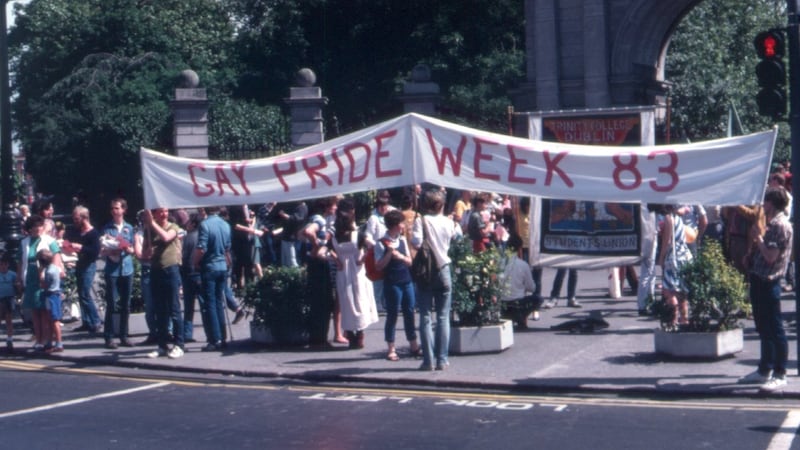

Foley: We were building on the momentum of what was happening with Fairview.
Izzy Kamikaze (DGC): I think if the Fairview Park march hadn’t happened, there would not have been a Pride march in Dublin as early as that.
Crone: The attitudes of the Gardaí, and especially the judge, brought the harsh reality of gay lives in the 70s and 80s into sharp focus and made straight people aware of the violence and discrimination that gay people suffered.
Kieran Rose (CGC): I was involved in the Cork Gay Collective. Ten or 15 came up for the Fairview march and then 20 or more for the Pride Parade. The Supreme Court had turned down David Norris’s appeal. It was a statement against all of that and against Fairview and the killers. We had our Cork Gay Collective Banners and a Gay Rights at Work banner because we were involved with the trade union.
O’Donnell: Lesbian Line, LIL and a lesbian social scene were well-established in Dublin and the other major cities in Ireland. Our visibility had increased. We were more than ready to take to the streets with our badges, banners and balloons.
Crone: 1983 also highlighted the differences between lesbian women and gay men. Gay men’s focus was on law reform to repeal the 1861 Offences Against the Person Act and to pressure politicians to do more to protect gay men from violence on the streets. Lesbian feminists were more concerned with violence in the home, equal pay and equal respect in the workplace, the struggle for lesbian mothers to keep custody of their children, the rejection and ostracism and, sometimes, violent reaction that young lesbian women suffered when they came out to their families.
Walsh: You can just get a glimpse of anti-amendment banners in the ‘83 march [photographs].
Kamikaze: There was a very lighthearted vibe from the off. I always thought there were several hundred people. Tonie Walsh has said he has counted heads in photographs and thought there was around 155. But I think a lot of people dodged the cameras in those days.
Walsh: We can contest the numbers, about a hundred of us, max 200. Imagine 200 people without wardens, without police, a rambunctious, noisy group of people?
Foley: I think it was over 1,000 ... You’d have people lining the streets, basically, to see how big the march was and if it was large enough, people felt they could join in anonymously. Usually, the march at the end was bigger than when it set out.
We partied into the night and for me, personally, the feeling of elation experienced that day stayed with me for weeks
— Pauline O'Donnell
Bill Hughes: I was watching from the footpath. I was very gauche and very naive and I just didn’t get it. I suppose I was scared. I was an active participant in the social aspect of being gay but I hadn’t yet learned the importance of being politicised. Within two years, not only did I get it, I f**king bathed in it. I was teaching and, at the time, you couldn’t be an out gay teacher. I kind of walked along beside it on the footpath. I was a slinky shadow.
Molloy: People would wear pink carnations and if you were really ambitious, you tried to dye your carnation green. [That’s] very difficult to do, by the way. I had a very smart pink bow tie, or I thought it was at the time. That was as cool as the look got then.
Kamikaze: We had a little book: Gays Against the Amendment, just so we could have the initials GAA.
Molloy: We wanted humour in our stuff. That’s a form of resistance too. GAA cracked us up. Later, the collective had a newsletter, called Quare Times. That was absolutely a joke. My mother would say, “Talk about quare times.” One year we had a car with a little tape deck playing Tom Robinson’s Glad to Be Gay. The battery was running down so the tape started playing ... really slowly. And, Bill Foley sang at the same speed as the tape. It was the saddest thing you ever heard but, of course, it cracked us up completely.
Walsh: The police didn’t want us to walk down Grafton Street and we went: “F**k it, we’re doing it.”
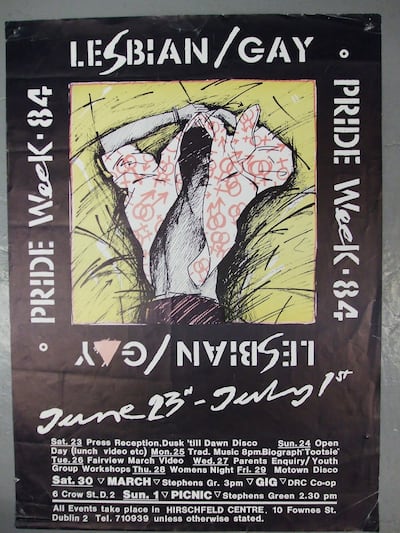
Molloy: People would sort of stare at you as if they couldn’t quite believe that this could be happening in Dublin. And that was always a thing we were super clear about – we were gay and Irish. One year, somebody created and printed “Guaranteed Gay” stickers, which were done in the style of the Guaranteed Irish badges.
Foley: It’s not unusual for dictators to say that there is no such thing as gay people in their countries. Ireland had that in the 70s and 80s – the idea that homosexuality was some sort of foreign import. The protests were really about asserting the fact that there were indigenous LGBT people in Ireland.
Hughes: Gays found their answers in the lyrics of songs. Doris Day’s Secret Love, “Once I have a secret love that lived within the heart of me.” Polari, the language invented by the Navy. [It] was all codes and languages and bywords. Nobody could be out.
Kamikaze: Somebody threw pink dye into the [Thomas Davis] fountain and it went pink as we were walking past it, which was an amazing moment.
Rose: The young people’s delight after the marriage referendum at Dublin Castle, we were just a version of what you can see in those photographs. There were just much fewer of us.
Walsh: The government had erected a viewing stand for the National Children’s Parade. We arrived at the GPO, commandeered the viewing stand. Joni Crone rededicated the GPO as the Gay People’s Organisation. Myself and Joni were speaking from tiny little speakers someone put on a car.
Molloy: You know that “Pride is a protest, not a parade” conversation? Well, it was a protest but it was a joyful protest. It felt very important to us that we didn’t seem downtrodden or beaten. It was two fingers up.
O’Donnell: We partied into the night and for me, personally, the feeling of elation experienced that day stayed with me for weeks.
Kamikaze: If I close my eyes, I can still picture it.
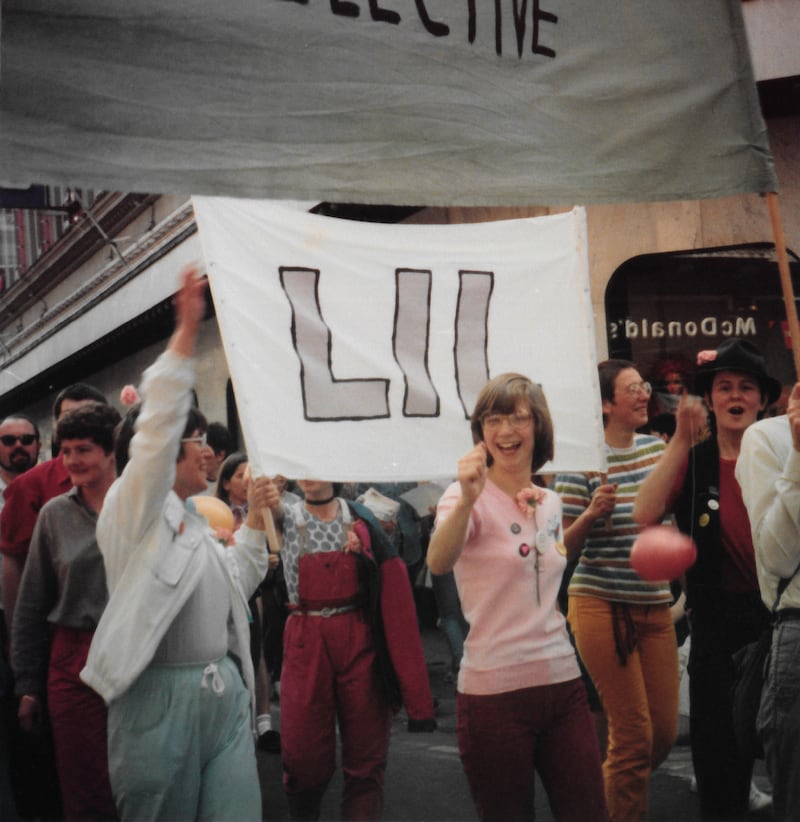
Later in the 1980s
Rose: It’s very interesting how the spirit can decline so quickly. I think the last march was in ‘85. It all rapidly disintegrated.
McDonagh: The last one was in 1985. Cathal Kerrigan got hit by a car.
Kamikaze: We wanted to stop the traffic for a moment.
Kerrigan: This shagger started up the engine and moved. I fell back on the bonnet. I rolled off, luckily. I’ve a photo of the scratches.
Kamikaze: The cops were beside me and I said, “Did you see that?” and [a garda] said, “See what?”
Molloy: I personally got hit by stones from flats as we walked past at Stephen’s Green, which, now, would be hanging out pride banners.
Kerrigan: We didn’t have the numbers to be safe.
McDonagh: Attention was focused on responding to the AIDS crisis. And we cannot underestimate how much effort that took.
Foley: We set about organising the first response to HIV in Ireland under the group name of Gay Health Action. The last political act of [the DGC] was the publication of a book called Out for Ourselves in ‘86.
Hughes: AIDS was my [political] wake up call. I lost my entire peer group to AIDS. And it made me re-examine everything. I nursed [Vincent Hanley] for the last few weeks of his life. I’d go to the Hirschfeld and they’d tilt their head to one side and go, “How are you?” wanting to know if I had it because they assumed I did. I didn’t go out for five years. From 1987 to 1992, there’s just a line through the social diary.
Foley: It was a time when we were losing all the battles.
Molloy: We knew we’d lose the abortion referendum but we thought we were going to win the [1986] divorce referendum. And we didn’t. And, I remember, for me, the lights went out and I actually talked seriously with my partner about wanting to emigrate, thinking, “I can’t take this country any more.” There was a huge wave of social emigration that was just women and gays. I think we sort of bled away, almost a generation.
Kamikaze: There was a seven-year gap [after Pride 1985] and then there was ‘92, which I think was very significant because it was pre-decriminalisation, peak-AIDS pandemic and the people who came together around that were people who were involved in ACT UP and Dublin Aids Alliance. We pulled it together at the last moment. Irish queers were in the news at the time because of the Paddy’s Day Parade in New York with the Irish Lesbian and Gay Organisation, ILGO. In ‘92, people had kind of forgotten about the early marches. Only a small number of people had been on the Pride marches in the early 80s. [In ‘92] I was wearing Doc Martens, fishnets, a red corset and a cape. Written down the back of the cape was “Zombie lesbian vampire from hell”.
Legacy
In 1988, David Norris won his case in the European Court of Human Rights. In 1993, the laws against homosexuality were repealed. In 2015, marriage equality passed by referendum and the Gender Recognition Act was introduced. Last year, an estimated 50,000 people attended Pride in Dublin.
McDonagh: Their level of resilience is just beyond comprehension for me. Their names should be household names. It wasn’t the lives of just the LGBT community they changed. They changed Irish society more broadly for the better.
Foley: The power of the church can’t be underestimated. It was very hard to step outside the norm of marriage and sexual morality. I knew being gay was normal and natural and if institutions were saying otherwise, it was all a huge lie.
Hold on to your friends because you have the shared activist history – you never lose your activism. The light dims for a while but it never goes out
— Maura Molloy
Norris: I never thought anything I did was brave. My father was a war hero. But I’m a state-registered coward. I don’t believe in being martyred. I believe in surviving and having a good life. The other day, I was coming across O’Connell Bridge and I saw two handsome young men holding hands. And I just thought that was absolutely lovely. The proof of the pudding is in the eating, as they say. Young people nowadays – young men – don’t believe that their private sexual actions were criminalised. They live in such a different world. And, it’s a much better world.
Kerrigan: People say to me, “We’ve got equal marriage. You won.” We didn’t win. Society won.
McDonagh: If history has told us anything, progress is not inevitable. We can become complacent. We need to be careful.
Kamikaze: It’s an awful lot easier for a giant corporation to change its logo to rainbow colours than it is to do anything actually meaningful for the community. I never wanted us to be establishment. I was speaking at Bród na Gaeltachta in Falcarragh last year, got involved in setting up Northwest Pride. To me, the real spirit is in the newest, smallest place to do it, the most challenging new ground that people are breaking. That’s where I want to be. Having said that, in the current atmosphere, it’s very important to take part in Dublin Pride and I will.
Walsh: We’ve bloody well fought to be on the streets in 2023. It’s been a bloody long and hard battle. We had to suffer the beatings, the spittings, the jeerings, just for the right to walk down the street holding hands.
[ Naoise Dolan: ‘Gay is a fun button to press. God should push it more often’Opens in new window ]
Molloy: If we weren’t activists, we would have gone mad. And so, activism and the friendships around that were a source of mental health resilience in our lives and also a source of joy. An awful lot of my really close, lifelong friends I met during days like that. Hold on to your friends because you have the shared activist history – you never lose your activism. The light dims for a while but it never goes out. We may have been relatively few but we were happy and proud to have created our own space in the world.
Thank you to the Irish Queer Archive and the National Library of Ireland, Edmund Lynch’s invaluable LGBTI+ Oral History Project, Dr Patrick’s McDonagh’s Gay and Lesbian Activism in the Republic of Ireland 1973-93, Dean Ruxton for research in The Irish Times archive, and all those who shared their memories with us.
The 2023 Dublin Pride march and parade takes place at noon on Saturday, June 24th, beginning at the north end of O’Connell Street. The Trans and Intersex Pride march takes place on Saturday, July 8th, marching from Parnell Square to Dáil Éireann.
In an earlier version of this article, the photograph of Hugo André Mac Manus protesting laws against homosexuality in 1974 was miscaptioned. We apologise to Hugo for the mistake.















